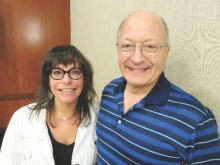CHICAGO – A new model of gastroesophageal reflux disease (GERD) paints it as a disease caused by inflammatory molecules, rather than a reaction to an acid-inflicted wound.
And rather than esophagitis due to GERD being a top-down process, from surface epithelium to submucosa, multiple lines of evidence now suggest it is a bottom-up phenomenon sparked by activation of a hypoxia-inducible factor that occurs when esophageal epithelium is exposed to acidic bile salts, Rhonda Souza, MD, said at the meeting sponsored by the American Gastroenterological Association.
“We’re proposing that reflux is a cytokine-mediated injury,” said Dr. Souza of the University of Texas Southwestern Medical Center, Dallas, and the Dallas VA Medical Center. “The reflux of acid and bile doesn’t destroy the epithelial cells directly, but induces them to produce proinflammatory cytokines. These cytokines attract lymphocytes first, which induce the basal cell proliferation characteristic of GERD. Ultimately, it’s these inflammatory cells that mediate the epithelial injury – not the direct caustic effects of gastric acid.”
Dr. Souza and her colleagues, including Dr. Stuart Spechler and Dr. Kerry Dunbar, also of UT Southwestern and the Dallas VA Medical Center, have been building this case for several years, beginning with a surgical rat model of GERD. Their histologic findings in this model have been recapitulated in human cell lines and, most recently, in a clinical trial of 12 patients (JAMA. 2016. doi:10.1001/jama.2016.5657).
The rat model, published in 2009 (Gastroenterology. 2009. doi:10.1053/j.gastro.2009.07.055) provided one of the first very early looks at the pathogenesis of acute GERD.
Rats underwent esophagoduodenostomy, a procedure that left the stomach in place so that both gastric and duodenal contents could reflux into the esophagus, thus ensuring immediate esophageal exposure to acid and bile acids. But the investigators were puzzled as to why it took weeks to see changes in the esophageal surface. “The epithelial mucosa stayed intact for far longer than it should have – up to 3 weeks – if acid simply caused a caustic injury as the mechanism of cell death and replacement,” Dr. Souza said.
What she did see, however, was a rapid migration of T cells into the submucosa. “By postoperative week 3, we observed profound basal cell and papillary hyperplasia, but the surface cells were still intact, so this hyperplasia was not due to the death of surface cells.”
The team proceeded to an in vitro model using esophageal squamous cell lines established from endoscopic biopsies obtained from GERD patients. When the squamous cells were exposed in culture to acidic bile salts, the cells ramped up their production of several proinflammatory cytokines, including interleukin-8 and interleukin-1b. The production of proinflammatory cytokines released into the surrounding media were potent recruitment signals for lymphocytes.
The researchers saw this same signaling response in their rat model. “We saw a dramatic increase in IL-8 by postoperative week 2. It was in the intracellular spaces between cells at the epithelial surface and in the cell cytoplasm, and we also saw it in the submucosa and in the lamina propria.”
Acute reflux esophagitis has been almost impossible to observe in humans, Dr. Souza said, because most patients don’t seek medical attention until they’ve had months or years of acid reflux symptoms. By then, the injury response to gastroesophageal reflux has become chronic and well established.
The human study, published in May, confirmed the findings in the rat model. It comprised 12 patients with severe GERD who had been on twice-daily proton pump inhibitor (PPI) therapy for at least 1 month. Successful PPI treatment heals reflux esophagitis rapidly, and healing was endoscopically confirmed at baseline in all these patients. Then, however, they gave up their medication so that the damage would begin again. Dr. Souza and her colleagues could travel back in time, clinically speaking, and track the histopatholgic changes as they occurred. Within 2 weeks, esophagitis had reappeared in every patient: Three had the least-severe LA (Los Angeles) grade A, four had LA grade B, and five had LA grade C esophagitis, with extensive mucosal breaks.
“We know from older studies that within 6 months of going off of PPIs, most patients with reflux esophagitis develop it again, but we weren’t sure we would get this response within 2 weeks. It was surprising that not only did everyone get it, but that a few were so severe,” Dr. Souza said.
Biopsies at weeks 1 and 2 showed the same kind of inflammatory signaling seen in the rats. Again, the responding cells were almost exclusively lymphocytes; neutrophils and eosinophils were very rare or absent in all specimens. The team also observed basal cell and papillary hyperplasia and areas of spongiosis, even though the surface cells were still intact.


